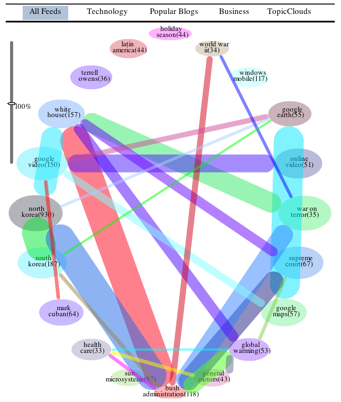Over the last few weeks I have been concentrating on more formal writing hence the limited number of blog entries. Once this formal writing reaches a point where I feel comfortable with the structure and content I will most probably publish it up here, until then hold tight. In the meantime I have come across a couple of very interesting links related to tagging and folksonomies that are worth remembering.
Folksonomy Generation
David Weinberger has a very interesting post and comment thread named 'What is a folksonomy anyway?' where he tries to come to terms with exactly what a folksonomy is and how it comes about. It is commonly agreed that a folksonomy is a set of user generated tags assigned to related pieces of content, but the real question is what role does the process of tag creation have to play in the establishment of a true folksonomy?
"In fact (I'd thought), if you really want a folksonomy to develop, you give people some feedback about how others are tagging the same or similar objects."
David Weinberger
By simply providing a mechanism for 'free tagging' of content does that generate a true folksonomy? Without feedback from other like minded users what typically results is independent sets of user generated tags that have marginal relationships with each other. When users are given feedback during the tagging process about how similar, hopefully like minded-people have tagged content then the tagging process gains more significance. Not only are common tags reinforced but individual or situation specific tags can be derived as well. From the looks of the comments opinion seems divided on this topic and there are good arguments backing up both sides.
From experience and the perspective of using folksonomies to aid in group work it is my opinion that providing feedback during the tagging process is a crucial element to a folksonomies success. In the Reasonate testing before team tagging feedback was provided tag use was limited by students and when applied was so distributed and unique that no useful relationships, search indexes or higher operating structure could be reasonably derived. Once tag feedback was applied in the form of either team or class level tag clouds students began to apply tags more consistently and frequently. In hindsight this feedback process would seem to fit human nature as it acted as an incentive. Group level suggestions also form a very useful starting point to any tag thought process, much like beginning to paint on a blank canvas can be daunting but by laying down a few initial strokes it gets the mind working and the paint flowing.
Tagging and its limitations
Tagging and folksonomies are not the solution to all of life's data problems as Abby from LibraryThing describes in her post entitled 'Tagging Meets Subject Headings'. Within the post she highlights the benefits of tagging such as its ability to capture data not directory associated with existing meta-data. She then goes on to explain where tagging is not so successful such as in cases where a piece of data is either one thing or another (true or false). Tagging is not good with binary decisions like this as it is indicative of a single opinion. Consequently the general perception is that associated tags indicate content is 'kind-of this' or 'mostly that' but not unquestionably one thing. Her advice like most things in this world is to apply tagging in moderation and when it is not the most appropriate source of meta-data always be prepared to seek other sources of data.
Visualisation of folksonomy relationships
A while back TechCrunch reviewed WizTag, a newish online RSS reader service. What got my attention was WizTag's TopicMap visualisation functionality which is similar in effect to Google Maps but for tag clouds. WizTag generates mind map diagrams of tag clouds complete with lines representing relationships that are scaled depending on the quantity and frequency of user submissions.

There is a little zoom feature that allows you to control the size of the diagram Google Maps style. Unfortunately I was disappointed with this feature mainly because it reminded me so much of Google Maps that on zooming in I half expected more data to be exposed but instead you just get a larger image of what is already onscreen. What I really wanted to see happen as I zoomed in was the individual tag topics get broken down into their component parts and relationships so that I could get a better idea of the specifics that made up a particular tag cloud. Not only would this have looked really cool but it would added an extra degree of understanding to the diagram that at the moment is a little boring once you get over the initial image. Still as you can the overall idea is quite effective in identifying areas of current interest and the strength by which different concepts are related to each other.
